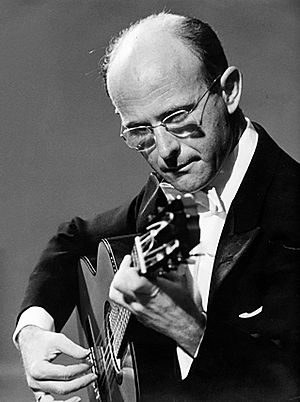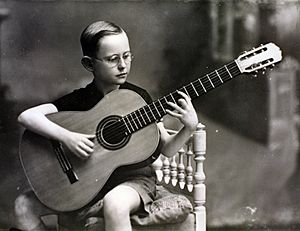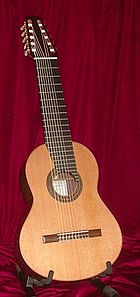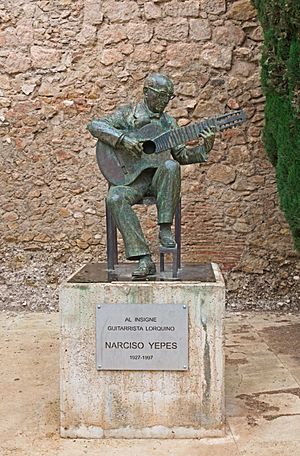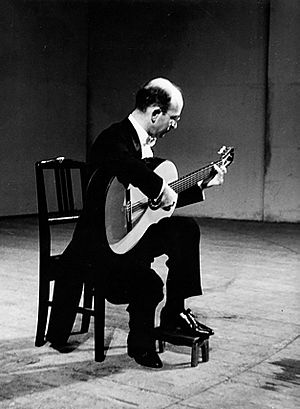Narciso Yepes facts for kids
Narciso Yepes (born November 14, 1927 – died May 3, 1997) was a famous Spanish guitarist. Many people think he was one of the best classical guitar players of the 1900s.
Contents
Biography
Narciso Yepes was born in Lorca, a town in the Region of Murcia. His family was not rich. When he was four, his father gave him his first guitar. His father would take him five miles on a donkey to his lessons three times a week. Yepes first learned guitar from Jesús Guevara in Lorca. In 1936, his family moved to Valencia because of the Spanish Civil War.
When he was 13, he was accepted to study at the Conservatorio de Valencia. He learned from a pianist and composer named Vicente Asencio. Yepes studied harmony, how to compose music, and how to perform. Many people say Yepes helped create a new way to play guitar. This method used the ring, middle, and index fingers of the right hand. Before this, guitar teachers usually taught students to use only the index and middle fingers.
Yepes' teachers were not guitarists. They pushed him to play faster and smoother, like a piano or violin. Yepes worked hard to match the speed of piano scales on his guitar. This helped him play music the way he wanted, not just the way the guitar usually allowed. Another musician, George Enescu, also encouraged Yepes to improve his playing speed.
On December 16, 1947, Yepes played his first big concert in Madrid. He performed Joaquín Rodrigo's famous Concierto de Aranjuez. Ataúlfo Argenta led the Spanish National Orchestra. This concert was a huge success. Critics and the public loved it. Soon, Yepes started touring with Argenta. They visited Switzerland, Italy, Germany, and France. Yepes helped make the Concierto de Aranjuez very popular. He made two early recordings of it with Argenta.
In 1950, after playing in Paris, Yepes spent a year studying music. He learned from violinist George Enescu and pianist Walter Gieseking. He also learned from Nadia Boulanger. After this, he spent a long time in Italy. There, he met many different artists.
In 1958, Yepes married Maria Szumlakowska in Paris. She was a philosophy student from Poland. They had two sons, Juan de la Cruz (who passed away) and Ignacio Yepes. Ignacio became an orchestral conductor and flautist. They also had a daughter, Ana Yepes, who became a dancer and choreographer.
In 1952, a piece of music called "Romance" became the main song for the film Forbidden Games (Jeux interdits). Yepes said he wrote this piece when he was a young boy. However, the song had been published before Yepes was born. The earliest known recording of it is from around 1900. In the film's credits, "Romance" is listed as "Traditional: arranged – Narciso Yepes." This means it was an old song that Yepes arranged for the film. Yepes also played other music for the Forbidden Games soundtrack. He later composed music for films like La Fille aux yeux d'or (1961). He also acted as a musician in the 1967 film El amor brujo.
In 1964, Yepes played the Concierto de Aranjuez with the Berlin Philharmonic Orchestra. For this concert, he introduced a new instrument: the ten-string guitar. He created this guitar with a famous guitar maker named José Ramírez III. This new guitar made it easier to play old music written for the lute. It also had a special feature: extra strings that made the sound richer, like a piano's sustain pedal.
After 1964, Yepes only used his ten-string guitar. He traveled all over the world, giving about 130 concerts each year. He played solo concerts and with major orchestras. In 1969, he recorded the Concierto de Aranjuez with his ten-string guitar for the first time.
Yepes was not just a great musician; he was also a serious researcher. He looked through old music papers from the 1500s and 1600s. This helped him find many forgotten pieces for guitar or lute. He was also the first person to record all of Bach's lute music using old instruments. Yepes also developed new ways of playing the guitar.
He received many awards, including the Gold Medal for Distinction in Arts from King Juan Carlos I. He also became a member of the Academy of "Alfonso X el Sabio." The University of Murcia gave him an honorary doctorate. In 1986, he won Spain's Premio Nacional de Música. He was also chosen to join the Real Academia de Bellas Artes de San Fernando.
In the 1980s, Yepes started a group called Trio Yepes. His son Ignacio played the flute and recorder, and his daughter Ana danced to her own choreography.
After 1993, Narciso Yepes played fewer public concerts because he was ill. His last concert was on March 1, 1996, in Santander, Spain.
He passed away in Murcia in 1997. He had been battling lymphoma, a type of cancer, for a long time.
What People Said About His Music
Some people had different opinions about Yepes' playing style. For example, he played Bach's Chaconne in a unique way. Yepes explained that he studied different versions and played it how he thought Bach would have written it for guitar.
Guitarist Ivor Mairants once asked Yepes why his playing was different from another famous guitarist, Andrés Segovia. Yepes replied that he admired Segovia, but he didn't need to copy him. He believed every musician should play in their own way.
Positive Comments
- "Narciso Yepes played Rodrigo's Concierto de Aranjuez very delicately. The many different sounds he could make were amazing."
- "Narciso Yepes brought his 10-string guitar to Carnegie Hall. Suddenly, it was easy to hear the instrument in that big space. His guitar filled the hall with sound. He is one of the best musicians in the world today." (1982)
- "Mr. Yepes' playing was known for its clear details and easy fast parts. He could also keep different musical lines clear. He used sound colors to highlight parts of the music. Yepes had great poetry and power in his playing."
- "With rare intelligence, Narciso Yepes made his audience quiet. This powerful effect only truly great performers can create."
- "Such amazing art, along with incredible technical skill, is rare among artists today."
- "Yepes is more than a brilliant player. He is a magician who needs only a rhythm or a chord to impress everyone."
- "He is a complete master of the guitar. He understands many guitar styles, from old Renaissance music to modern pieces."
- "Other good guitarists have visited Japan, but none showed such delicacy and beauty in the instrument as Yepes."
- "We believe Yepes is the most complete guitarist of our time."
- "An admirable musician, a master of his instrument. His playing is strong and not overly emotional. The audience showed their excitement with applause. It was well deserved."
- "His musical personality was very wide. Just three opening pieces showed Mr. Yepes as a lively, expressive, and clear performer."
- "If the guitar's beauty is in its sounds, then Narciso Yepes is one of the best poets of the instrument. In his concert, Yepes created a range of sounds and feelings that few guitarists today could match."
- "Yepes was a great teacher. He used humor and information to help students learn. He always focused on a student's strengths, saying, 'As you grow in your strengths, you will forget your weaknesses.'"
- "Finally, we have a real change from the Segovia style of playing, not just an echo."
- "For this reviewer, his performance was more varied, more enjoyable, and more skillful than even the legendary Segovia."
- "Perfect, flowing melodies came from the unique ten-string guitar. There were flashes of Spanish fire and passion. But mostly, the songs were softer, like a dream. It felt like being transported to a sunny, faraway land."
- "The sonatas by Scarlatti gave the performer a chance to delight his audience with his unusually wide range of sounds. Narciso Yepes' playing was perfect in every detail."
- "Yepes amazed the audience with his insightful and technically brilliant playing."
- "This is a special 'Aranjuez,' full of Yepes' unique changes to the music. It had rhythmic freedom and his own coloring. The orchestra's part was also rebalanced by conductor Garcia Navarro." (Allan Kozinn, New York Times, 1981)
- "Narciso Yepes is not only a great player of this music, but he also has a rare gift. He always creates excitement when recording. All his music comes alive."
- "A concert with the Paris Conservatoire Orchestra included a wonderfully controlled performance of Joaquín Rodrigo's Guitar Concerto with Narciso Yepes. This must be the only successful concerto written for the instrument. The beautiful balance of ideas and sounds is always a fresh delight."
- "Narciso Yepes is my favorite guitarist, besides the [Romero] family. And of course, Bream, I enjoy him. But the one I enjoy the most is Narciso Yepes."
- "Yepes' success was in his right hand. He could make many different sounds. This was partly because of his vibrato and how he changed sounds on the fingerboard. But mostly, it was because he carefully and accurately placed his plucking fingers."
- "It seemed like everyone in the audience stopped breathing during the slow movement of Joaquin Rodrigo's 'Concierto de Aranjuez.' Yepes played it with such delicacy, attention to detail, and clear beauty that it captivated everyone."
Recordings
Narciso Yepes made many recordings throughout his career. You can find some of his recordings at Deutsche Grammophon Gesellschaft.
Some of his well-known recordings include:
- "La Fille aux Yeux d'Or" (original film soundtrack)
- "Jeux Interdits" (Original film soundtrack)
- "Falla/Rodrigo" (Concierto de Aranjuez)
- "Spanish Classical Guitar Music"
- "Joaquín Rodrigo: Concierto de Aranjuez, Fantasía para un Gentilhombre"
- "Johann Sebastian Bach: Werke für Laute" (Works for Lute – Complete Recording on Period Instruments)
- "Romance d'Amour"
Music Written for Narciso Yepes
Many composers wrote music especially for Narciso Yepes or dedicated pieces to him. This shows how important he was in the world of classical guitar. Some of these composers include:
- Joaquín Rodrigo
- Manuel Palau
- Salvador Bacarisse
- Maurice Ohana
- Cristóbal Halffter
- Leo Brouwer
- Leonardo Balada
- Antonio Ruiz-Pipó
- Vicente Asencio
- Bruno Maderna
- Tomás Marco
- Xavier Montsalvatge
- Jean Françaix
- Federico Mompou
- Alan Hovhaness
|
See also
 In Spanish: Narciso Yepes para niños
In Spanish: Narciso Yepes para niños


